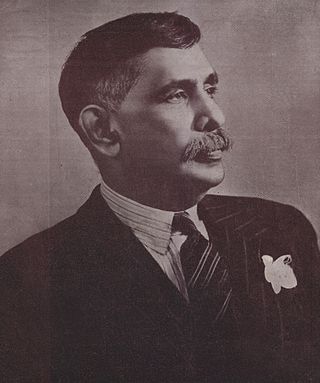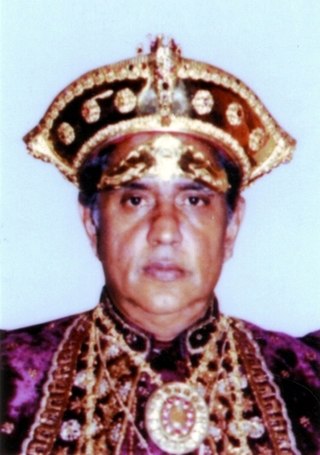Related Research Articles

Don Stephen Senanayake was a Ceylonese statesman. He was the first Prime Minister of Ceylon having emerged as the leader of the Sri Lankan independence movement that led to the establishment of self-rule in Ceylon. He is considered as the "Father of the Nation".

Solomon West Ridgeway Dias Bandaranaike, also known as "The Silver Bell of Asia", was the fourth Prime Minister of the Dominion of Ceylon, serving from 1956 until his assassination. The founder of the left-wing and Sinhalese nationalist Sri Lanka Freedom Party, his tenure saw the country's first left-wing reforms.

Dominicus Corea also known as Domingos Corea and Edirille Rala, was the son of Don Jeronimo Corea and Anna Corea. Don Jeronimo Corea was also known as Mudaliyar Vikramasinha, Commander-in-Chief of King Mayadunne's army. Jeronimo Corea was executed by King Mayadunne's son, Rajasinghe. Dominicus Corea was born in Colombo in 1565. At that time, the Portuguese had colonised Ceylon, and his parents converted to Catholicism.

Kala Suri Alhaj Kareem Mohideen Baig, popularly as Mohideen Baig, was a Sri Lankan musician. One of the most influential singers in Sinhala music, Baig is known particularly for his Buddhist devotional music. He is a Muslim who moved to Sri Lanka from Salem in Tamil Nadu, but of a Hyderabadi Muslim origin. He was considered a highly influential multicultural figure in the country's arts history. Baig is the first award winning citizen of Sri Lanka.

Charles Henry de Soysa Dharmagunawardana Vipula Jayasuriya Karunaratna Disanayaka popularly known as Charles Henry de Soysa, JP was a Ceylonese entrepreneur and philanthropist. He was a pioneering planter, industrialist and was the wealthiest Ceylonese of the 19th century. He was instrumental in the establishment of the first Ceylonese bank, the Moratuwa carpenters guild, the Ceylon Agricultural and National Associations. He is widely regarded as the greatest philanthropist of the island for contributions which includes the De Soysa Maternity Hospital, the Prince and Princess of Wales Colleges, the Model Farm Experimental Station and many other institutions and acts of charity, establishing infant-maternal healthcare and secular education for girls in the country. He would have been the island's first Knight Bachelor, but having died prior, his widow was given the rare honor of the use of the style and dignity of wife of the Knight Bachelor and was known as Catherine, Lady de Soysa.

Deshamanya Nissanka Parakrama Wijeyeratne, known as Nissanka Wijeyeratne, was a Sri Lankan politician, civil servant, diplomat and English language poet. He was also the Diyawadana Nilame of the Sri Dalada Maligawa, Kandy from 1975 to 1985. At the time of death he was serving as the chairman of The Law and Society Trust in Sri Lanka.

Sir James Peiris was a prominent leader in the Sri Lankan independence movement, the first elected Vice-President of the Legislative Council of Ceylon and the first native Governor of Ceylon (Acting).
Pandukabhaya was king of Upatissa Nuwara and the first monarch of the Anuradhapura Kingdom and 6th over all of the island of Sri Lanka since the arrival of the Vijaya; he reigned from 437 BC to 367 BC. According to many historians and philosophers, he is the first truly Sri Lankan king since the Vijayan migration, and also the king who ended the conflict between the Sinha clan and the local clans, reorganizing the population.

Savumiamoorthy Arumugam Ramanathan Thondaman was a Sri Lankan politician who served as a Cabinet Minister. He was the grandson of prominent unionist Saumyamoorthi Thondaman. He was the leader of the Ceylon Workers' Congress, a Member of Parliament representing the Nuwara Eliya District and was an advocate for the Indian Tamils of Sri Lanka. His career as a politician spanned over 20 years, holding several ministerial portfolios in different governments. He was regarded as one of the prominent politicians from Nuwara Eliya.

George Rajapaksa was a Sri Lankan politician. He was the former Cabinet Minister of Health, Fisheries and a Member of Parliament.

Charles Edgar Corea (1866-1946) was a politician and a prominent freedom fighter of Sri Lanka.

Gate Mudaliyar James Edward Corea was a Ceylonese colonial-era headman.

James Alfred Ernest Corea was a Sri Lankan public official. He was born in 1870. His father was Charles Edward Bandaranaike Corea who was a Proctor of the Supreme Court. His mother was Henrietta Seneviratne. J.A.E Corea's father died in 1872 when his youngest son Victor was just one. His wife Henrietta was a widow from the age of 21.

Charles Edward Victor Seneviratne Corea was born in Chilaw, Sri Lanka, on 29 January 1871 to Charles Edward Bandaranaike Corea, a famous lawyer, and Henrietta Seneviratne. He was the youngest out of five children, three boys and two girls, Charles Edgar Corea, James Alfred Ernest Corea, Agnes Corea and Evangeline Corea. This family was acknowledged to be one of the wealthiest families in the whole of Ceylon. Victor's family was severely affected when Charles Edward Bandaranaike Corea died in 1872, leaving five children, of whom the youngest, Victor Corea, was only one year old. The five young children depended on their young, widowed 21-year-old mother to look after them. He attended the prestigious S. Thomas' College, Mount Lavinia, where he excelled in his studies.
Srikumaradas Charles Shirley Corea was a Sri Lankan politician. He was the 9th Speaker of the Parliament and a Member of Parliament, representing Chilaw. He was a member of the United National Party of Sri Lanka.

Mahatma Gandhi the 'Father of the Nation of India,' paid a historic visit to Ceylon in 1927. On his first and only visit to the island, he was invited to Chilaw by the famed freedom fighters of Sri Lanka, Charles Edgar Corea and his brother Victor Corea. In addition to Chilaw, Mahatma Gandhi had visited Colombo, Kandy, Galle, Jaffna, Nuwara Eliya, Matale, Badulla, Bandarawela, Hatton and Point Pedro during his three-week-long visit to Sri Lanka and made many speeches to Sri Lankan audiences. During his stay in Ceylon he also visited the schools established by the Buddhist Theosophical Society in Ceylon namely Ananda College in Colombo, Mahinda College in Galle and Dharmaraja College in Kandy.

Sir Hilarion Marcus Fernando, FRCP was a pre-independence Ceylonese statesman, physician and banker. He was a member of both the executive council and legislative council as well as the chairman of the State Mortgage Bank of Ceylon.

Leslie Simon Goonewardene was a prominent Sri Lankan statesman. He founded Sri Lanka's first political party, the Lanka Sama Samaja Party, in 1935, and served as its General-Secretary from 1935 to 1977. Goonewardene was a key figure in both the Indian independence movement and the Sri Lankan independence movement. He was designated as a National Hero of Sri Lanka for his leadership in the independence movement, and his efforts are celebrated each year on the Sri Lankan Independence Day.

Mohamed Ehuttar Hadjiar Maharoof was a Sri Lankan politician and Member of Parliament.
Jeevan Thondaman is a Sri Lankan politician, Member of Parliament and Cabinet minister.
References
- ↑ Obeyesekere, Donald (1999). Outlines of Ceylon history. Asian Educational Services. ISBN 9788120613638 . Retrieved 12 December 2011.
- ↑ "Sri Lanka Sinhala Royal Family Genealogy". Rootsweb. Retrieved 12 December 2011.
